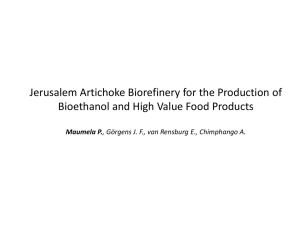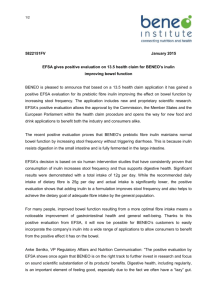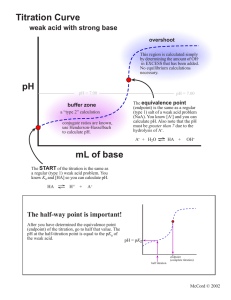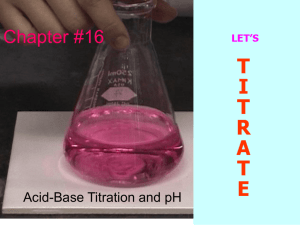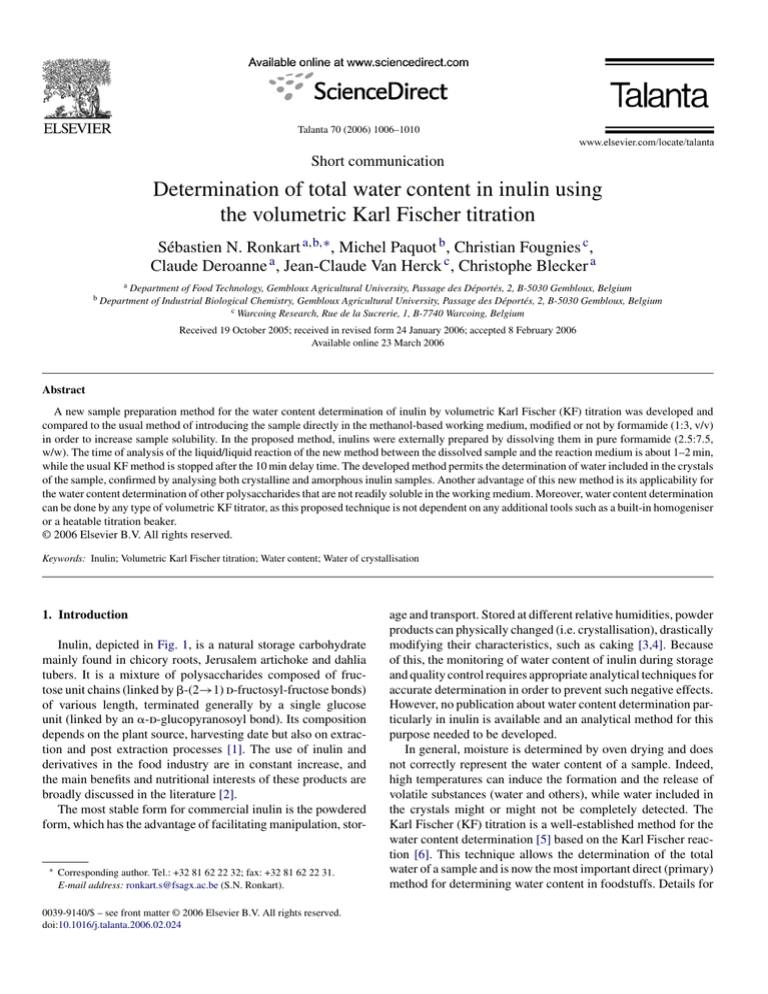
Talanta 70 (2006) 1006–1010
Short communication
Determination of total water content in inulin using
the volumetric Karl Fischer titration
Sébastien N. Ronkart a,b,∗ , Michel Paquot b , Christian Fougnies c ,
Claude Deroanne a , Jean-Claude Van Herck c , Christophe Blecker a
b
a Department of Food Technology, Gembloux Agricultural University, Passage des Déportés, 2, B-5030 Gembloux, Belgium
Department of Industrial Biological Chemistry, Gembloux Agricultural University, Passage des Déportés, 2, B-5030 Gembloux, Belgium
c Warcoing Research, Rue de la Sucrerie, 1, B-7740 Warcoing, Belgium
Received 19 October 2005; received in revised form 24 January 2006; accepted 8 February 2006
Available online 23 March 2006
Abstract
A new sample preparation method for the water content determination of inulin by volumetric Karl Fischer (KF) titration was developed and
compared to the usual method of introducing the sample directly in the methanol-based working medium, modified or not by formamide (1:3, v/v)
in order to increase sample solubility. In the proposed method, inulins were externally prepared by dissolving them in pure formamide (2.5:7.5,
w/w). The time of analysis of the liquid/liquid reaction of the new method between the dissolved sample and the reaction medium is about 1–2 min,
while the usual KF method is stopped after the 10 min delay time. The developed method permits the determination of water included in the crystals
of the sample, confirmed by analysing both crystalline and amorphous inulin samples. Another advantage of this new method is its applicability for
the water content determination of other polysaccharides that are not readily soluble in the working medium. Moreover, water content determination
can be done by any type of volumetric KF titrator, as this proposed technique is not dependent on any additional tools such as a built-in homogeniser
or a heatable titration beaker.
© 2006 Elsevier B.V. All rights reserved.
Keywords: Inulin; Volumetric Karl Fischer titration; Water content; Water of crystallisation
1. Introduction
Inulin, depicted in Fig. 1, is a natural storage carbohydrate
mainly found in chicory roots, Jerusalem artichoke and dahlia
tubers. It is a mixture of polysaccharides composed of fructose unit chains (linked by -(2→1) d-fructosyl-fructose bonds)
of various length, terminated generally by a single glucose
unit (linked by an ␣-d-glucopyranosoyl bond). Its composition
depends on the plant source, harvesting date but also on extraction and post extraction processes [1]. The use of inulin and
derivatives in the food industry are in constant increase, and
the main benefits and nutritional interests of these products are
broadly discussed in the literature [2].
The most stable form for commercial inulin is the powdered
form, which has the advantage of facilitating manipulation, stor-
∗
Corresponding author. Tel.: +32 81 62 22 32; fax: +32 81 62 22 31.
E-mail address: ronkart.s@fsagx.ac.be (S.N. Ronkart).
0039-9140/$ – see front matter © 2006 Elsevier B.V. All rights reserved.
doi:10.1016/j.talanta.2006.02.024
age and transport. Stored at different relative humidities, powder
products can physically changed (i.e. crystallisation), drastically
modifying their characteristics, such as caking [3,4]. Because
of this, the monitoring of water content of inulin during storage
and quality control requires appropriate analytical techniques for
accurate determination in order to prevent such negative effects.
However, no publication about water content determination particularly in inulin is available and an analytical method for this
purpose needed to be developed.
In general, moisture is determined by oven drying and does
not correctly represent the water content of a sample. Indeed,
high temperatures can induce the formation and the release of
volatile substances (water and others), while water included in
the crystals might or might not be completely detected. The
Karl Fischer (KF) titration is a well-established method for the
water content determination [5] based on the Karl Fischer reaction [6]. This technique allows the determination of the total
water of a sample and is now the most important direct (primary)
method for determining water content in foodstuffs. Details for
S.N. Ronkart et al. / Talanta 70 (2006) 1006–1010
1007
alternative methodology based on the introduction of an inulin
solution in pure formamide was developed and compared to the
standard KF titration.
2. Experimental
2.1. Materials
Fig. 1. Chemical structure of inulin. Image obtained by the Qmol version 3.0
software (Gans J.D. from the Cornell University) with a Ball and stick rendering.
Courtesy to PhD Nicolas Delsaux from the ‘Centre de Biophysique Moléculaire
Numérique’, Agricultural University of Gembloux.
the KF titration principle were described elsewhere [7]. KF
reagents based on methanol are considered toxic. For this reason, Schöffski [8] tested other reagents replacing methanol by
ethanol, but they are less adapted for water content determination in polysaccharides. Indeed, to determine the water content
of the sample, it must be dissolved in the reaction medium, used
as solvent. In some cases, the medium does not completely dissolve the sample. In order to increase solubility, some authors
used an internal homogeniser [9–11], worked at elevated temperatures [12–16], modified the polarity of the working medium
by adding further solvents to it [17] or pre-extracted the water
[18].
These methodologies using the KF titration present some
inconveniences as not all titration devices are equipped with an
internal homogeniser or a heatable titration vessel, which limits
the use of these techniques for wider applications. More so, at
high temperature, possible evaporation of sulphur dioxide from
the boiling working medium makes a reflux condenser necessary
[12]. Pre-extraction of water is not a broadly discussed method
in literature. Moreover, the supernatant containing the extracted
water does not in all cases include the water of crystallisation, as
a residue is still present. The addition of solvent in the reaction
cell seems to be the most adequate technique for solubilizing
samples in the working medium. However, the combination of
some methodologies like the adding of a further solvent (i.e.
formamide) in the medium with heating of the system or the
utilization of a homogeniser, lead to some side reactions, falsifying the water content determination. Schmitt and Isengard
[14] reported that formamide in the medium led to a higher drift
because of a side reaction. However, when the drift was taken
into account, they found values in accordance with the theoretical value. This phenomenon is known to occur particularly
at high temperatures (i.e. 50 ◦ C) and is much less expressed at
lower temperatures.
The aim of the present study was to develop a suitable sample preparation for the total determination of water content of
inulin, which can be present in an amorphous or crystalline state.
For this purpose, inulin samples were analysed by KF titration
using the usual method of introducing the powder directly in the
methanol base-working medium, modified or not by formamide
(1:3, v/v) in order to increase sample solubility. In addition, an
2.1.1. Inulin samples
The inulin samples used were two industrial spray dried products extracted from chicory roots, one purchased from Orafti
(inulin 1) and the other kindly supplied by Warcoing (inulin
2) both located in the Walloon Region (Belgium). They were
placed into Petri dishes (six replicates) and stored for 3 weeks in
hermetically closed containers containing P2 O5 at 20 ◦ C. This
storage was done in order to eliminate the free water.
Determination of the molecular mass distribution of the
samples was done by High Performance Anion Exchange
Chromatography coupled with Pulse Amperometric Detection
(HPAEC-PAD) on a Dionex DX500 chromatographic system
operating at 1 ml min−1 . About 25 l of 0.8 g l−1 solution were
injected. Separation of the various chain lengths was achieved on
a Dionex PA100 column as described by Ronkart et al. [4]. The
mobile phase consisted of sodium hydroxide (150 mM) elution
in isocratic mode, followed by a linear gradient with a solution
containing both sodium hydroxide (150 mM) and sodium acetate
(1 M). The gradient ended by washing with sodium hydroxide
500 mM. Relative response factors of the various species were
taken from Timmermans et al. [19] and Kang [20]. Inulin 1 and
2 had an average degree of polymerisation number (DPn ) and
weight (DPw ) of about 26 and 31 and 23 and 30, respectively.
Determination of crystallinity was done by a PW3710 Philips
Analyical X-ray B.V. static Wide Angle X-ray Scattering
(WAXS) diffractometer, using a Ni filtered Cu K␣ radiation,
generated by an anode device operating at 40 kV and 30 mA
in conjunction with a proportional detector. The patterns were
recorded with a fixed time of 0.4 s per step of 0.02◦ in the
4 < 2< 30◦ range [4,21]. Fig. 2 shows the amorphous state of
inulin 1 as only a flat diffractogram is present, while inulin 2
contains several diffraction peaks surimposed on an amorphous
halo, hence confirming the semi-crystalline nature of this sample.
Fig. 2. Static wide angle X-ray scattering (WAXS) diffractograms of inulin
samples. (1) inulin 1 and (2) inulin 2.
1008
S.N. Ronkart et al. / Talanta 70 (2006) 1006–1010
2.1.2. Karl Fischer titration
The KF titration was carried out with a Karl Fischer titrator DL31 from Mettler Toledo using the two-component technique with Hydra-Point Solvent G and Hydra-Point titrant (5 mg
H2 O/ml), both purchased from J.T. Baker (Deventer, Holland).
The polarising current for bipotentiometric end-point determination was 20 A and the stop voltage 100 mV. The end-point
criterion was the drift stabilisation (15 gH2 O min−1 ) or maximum titration time (10 min). The water content was calculated as
described by Scaccia [22], and the measurement was corrected
for the baseline drift, defined as the residual or penetrating water
that the apparatus removes per minute.
For better sample dissolution, the working medium was modified by adding formamide pro analyse min 99% purchased from
Merck (Leuven, Belgium).
2.2. Methods
2.2.1. Experimental precaution
Traces of water can penetrate into the titration vessel from the
exterior through tubes and joints. For this reason, before starting experiments, 15 ml of titrating agent were washed through.
Then, the exact water equivalent of the titrant component was
determined by analysing a water standard reference (apura®
Water standard 1% standard for volumetric Karl Fischer Titration, Merck KGaA, Darmstadt, Germany). Before starting an
experiment (drift or water equivalent determinations) or introducing the sample into the working medium for water determination, the cell was titrated to dryness. In the course of time, a
slight reagent consumption to keep the titration cell dry is always
observed. This so-called drift (expressed in g water min−1 ) is
due to water intruding through the tubes and joints. For precise
analyses, especially when the determination times were long,
consumption due to the drift was subtracted from the result, taking the titration time into account. Sample analyses were started
when the drift was lower than 10 g water min−1 .
2.2.2. KF titration of powdered inulin
About 250 mg of inulin was introduced in the reaction cell.
The latter contained either only the methanolic KF working
medium or a modified one with additional formamide (1:3, v/v)
in order to increase the solubility of these samples.
All mass determinations were carried out by back-weighing,
using a Sartorius BP61S balance (±0.0001 g). Thus, the exact
sample weight was determined only after adding the sample
into the titration cell. Stirring time in the cell before titration
was fixed at 20 s. Six analyses were performed for each method
and sample, and the respective results were averaged.
2.2.3. KF titration of inulin solution in formamide
About 2.5 g of inulin were dissolved in 7.5 g pure formamide
in a 15 ml Falcon® tube and heated at 45 ◦ C for 30 min, then
vortexed until complete dissolution. Then, about 1.5 g of this
25% (w/w) solution was injected in the reaction cell using a
syringe.
Beforehand, to determine if inulin was totally dissolved in
the formamide solution, a solubility test was performed. Inulin
2 (less soluble in formamide than inulin 1) was dissolved in
formamide in the 1–35% (w/w) range. These solutions were
then centrifuged at 30,000 × g for 1 h and the supernatants
were checked by HPAEC-PAD as described above. Results have
shown a total solubility up to 25% (w/w) and a slight decrease
above this concentration. For this reason, the chosen concentration for sample preparation in formamide was 25% (w/w).
3. Results and discussion
Water content calculated for the inulin samples by volumetric
KF titration are summarized in Table 1.
3.1. Analysis of powdered inulin by KF titration without
formamide in the working medium
The water content found for inulin 1 and 2 was 1.27 and
1.10 g water/100 g anhydrous inulin, respectively. However, the
dissolution of the product was not complete, as the working
medium was very cloudy, and the analysis was stopped by the
imposed maximum titration time of 10 min and not by the drift
criterion. So, the water content was underestimated for both
samples. This phenomenon can be related with the way the endpoint indication is fixed. Indeed, the volumetric KF titration is
based on the following two-step reaction:
R–OH + SO2 + B → BH+ + ROSO2 −
(1)
BH+ + ROSO2 − + I2 + H2 O + 2B
→ 3BH+ + ROSO3 − + 2I−
(2)
R–OH + SO2 + I2 + H2 O + 3B
→ BH+ + ROSO3 − + 2I−
(3)
Table 1
Results of the Karl Fischer titration (g water/100 g anhydrous sample) of inulin, by the conventional KF titration (with or without formamide in the working medium)
and for the proposed KF method, all performed at 20 ◦ C
Sample
Inulin 1
Inulin 2
a
Proposed KF methoda
Conventional KF method
Without formamidea
With formamidea
1.3 ± 0.3 (>10 min)
1.1 ± 0.3 (>10 min)
2.1 ± 0.1 (4–5 min)
1.8 ± 0.3 (>10 min)
In parentheses, the titration time in min.
2.1 ± 0.2 (1–2 min)
2.4 ± 0.1 (1–2 min)
S.N. Ronkart et al. / Talanta 70 (2006) 1006–1010
In the first step, an alcohol ROH (usually methanol) is esterified with sulphur dioxide. To obtain a quantitative reaction, the
ester is neutralised by a base B (usually imidazole) to yield alkyl
sulphite (Eq. (1)). In the second step, alkyl sulphite is oxidised
by iodine to give alkyl sulphate in a reaction that requires water.
The base, again, provides for a quantitative reaction (Eq. (2))
[23].
Two platinum electrodes are submerged in the working
medium and are polarized by a constant current. A certain
voltage is necessary to maintain this current. When it falls
and remains below a certain chosen value for a chosen time,
the so-called stop delay time, the analysis is stopped. Another
stop criterion is the drift. When the reagent consumption rate
reaches the same (or a slightly higher) value as immediately
before the start of the analysis, it is assumed that all the water
of the sample is detected, and the analysis is stopped. Additionally, it is possible to set a maximum determination time,
which must not be exceeded. If the determination is stopped
after this maximum time, the analysis is incomplete, since
the “real” stop criteria have not been fulfilled. In this case,
as the samples were not completely dissolved, water diffusion was low and delayed, so iodine was continually consumed
keeping the titration rate above the drift value. Thus, since
the measurement was stopped after 10 min and not because
water detection was complete, it would have been necessary
to increase the maximum titration time to allow the water to
reach the working medium completely by diffusion and extraction.
3.2. Analysis of powdered inulin by KF titration with
formamide in the working medium
In comparison with the analysis of powdered inulin by KF
titration without formamide in the working medium, analysis
of inulin 2 was still stopped by the maximum time (10 min),
whereas the analysis of inulin 1 was stopped by the drift criterion after 4–5 min. The addition of formamide led to a higher
water content estimation. Indeed, 2.07 and 1.83 g water/100 g
anhydrous inulin for inulin 1 and 2 were found, instead of 1.27
and 1.10 g water/100 g anhydrous inulin (without formamide).
We can correlate this phenomenon with the fact that the addition
of formamide to the medium leads to a complete extraction of
the water between the amorphous particles of inulin 1, while the
extraction of the partially crystalline inulin was not completely
achieved.
Although Wünsch and Schöffski [24] claimed that formamide accelerated the iodination of imidazole, leading to
slightly over-estimated water content values, we assumed that
formamide up to one third by volume did not yield false
results. Indeed, the analysis of a 1% water standard before
and after the formamide addition in the working medium
led to the same mean values even if the addition of formamide to the system delayed the reaching of the drift criterion.
By adding formamide in the methanol-based medium (1:3,
v/v), an increase of the water content value is obtained because
of a better solubility of the sample.
1009
3.3. Analysis of inulin dissolved in formamide by KF
titration
Water content was calculated by subtracting the water content
of formamide. The latter was determined before experimentation
and was 0.03 g water/100 g formamide.
Inulin 1 analysis led to the same water content determination
as the introduction of inulin powder in the titration cell with addition of formamide (2.07 g water/100 g anhydrous inulin), but the
analysis time was reduced by at least a factor 2. However, the
water content of inulin 2 was higher than that analysed by the
introduction of inulin powder in the titration cell. This difference
is probably due to the release of water entrapped in the crystals of
the semi-crystalline products. So, it can be assumed that the proposed method fully extracts the water content of inulin samples.
In addition, the analysis time was only 1–2 min, due to the immediate availability of the water. This shorter analysis time reduces
the influence of a possible change of the drift during the analysis.
The developed method has a higher precision of the measurements than the methods with incomplete water detection. It is
well adapted when the water content of the sample is low.
4. Conclusion
The total water content of inulin has been determined by volumetric Karl Fischer titration, using a complete pre-dissolution
of the sample in pure formamide, and was compared to the usual
introduction of the sample directly in the methanol-based working medium, modified or not by addition of formamide (1:3, v/v)
in order to increase sample solubility. The described method
allowed the determination of water included in the crystals,
as shown by comparing the results for amorphous and semicrystalline inulin samples.
The titration time for the proposed method was 1–2 min,
while complete water detection was not achieved after 10 min
by the standard method. Dissolving the sample beforehand and
transferring an aliquot into the titration cell is time consuming,
but this is compensated by the shorter titration time. This advantage is even more important, when routine analyses are carried
out and several samples can be dissolved simultaneously [18].
Moreover, the proposed method has the advantage of working
at ambient temperature and can be applied to every volumetric
KF titrator.
This methodology can be applied for the water content determination of other polysaccharides presenting a solubility problem in the working medium.
Acknowledgments
Financial support for this study was provided by the Walloon
Region of Belgium and Warcoing Research sprl. The authors
are grateful to Mrs. Lynn Doran for technical assistance. Mrs.
Bernadette Norberg and Prof. Johan Wouters from the ‘Department of Structural Biologial Chemistry’ of the ‘Facultés universitaires Notre Dame de la Paix’ (Namur, Belgium) are also
acknowledged for the static WAXS experiments.
1010
S.N. Ronkart et al. / Talanta 70 (2006) 1006–1010
References
[1] C. Blecker, C. Fougnies, J.-C. Van Herck, J.-P. Chevalier, M. Paquot, J.
Agric. Food Chem. 50 (2002) 1602.
[2] C. Blecker, J.-P. Chevalier, J.-C. Van Herck, C. Fougnies, C.
Deroanne, M. Paquot, Recent Res. Dev. Agric. Food Chem. 5 (2001)
125.
[3] S. Ronkart, C. Fougnies, M. Paquot, L. Doran, C. Deroanne, B. Norberg,
C. Blecker, Proceedings of the Communication at the Fifth International
Fructan Symposium, December 5–9, Havana, Cuba, 2004, ISBN 959-235022-1.
[4] S. Ronkart, C. Blecker, C. Fougnies, J.-C. Van Herck, J. Wouters, M.
Paquot, Carbohyd. Polym. 63 (2006) 210.
[5] S.K. MacLeod, Anal. Chem. 63 (1991) 557A.
[6] K. Fischer, Angew. Chem. 48 (1935) 394.
[7] S. Grünke, G. Wünsch, Fresen. J. Anal. Chem. 368 (2000) 139.
[8] K. Schöffski, Food Control 12 (2001) 427.
[9] H.-D. Isengard, M. Nowotny, Dtsch. Lebensm. Rundsch. 87 (1991) 176.
[10] H.-D. Isengard, Eur. Food Sci. ZFL 42 (1991) 1.
[11] C.A. De Caro, Mettler-Toledo Application Brochure, 27, No. 51725053,
1999.
[12] H.-D. Isengard, U. Striffler, Fresen. J. Anal. Chem. 342 (1992) 287.
[13] H.-D. Isengard, K. Schmitt, Mikrochim. Acta 120 (1995) 329.
[14] K. Schmitt, H.-D. Isengard, Fresen. J. Anal. Chem. 357 (1997) 806.
[15] K. Schmitt, H.-D. Isengard, Fresen. J. Anal. Chem. 360 (1998) 465.
[16] W. Supartono, S. Rückold, H.-D. Isengard, Lebensm. Wiss. u. Technol 31
(1998) 402.
[17] H.-D. Isengard, P. Heinze, Food Chem. 82 (2003) 169.
[18] H.-D. Isengard, M. Nowotny, Dtsch. Lebensm. Rundsch. 88 (1992) 246.
[19] J.W. Timmermans, M.B. van Leeuwen, H. Tournois, D. de Wit, J.F.G.
Vliegenthart, J. Carbohyd. Chem. 13 (1994) 881.
[20] S.-I. Kang, Ph.D. Thesis, Department of Agricultural Chemistry, Seoul
National University, Korea, 1999.
[21] C. Blecker, J.-P. Chevalier, C. Fougnies, J.-C. Van Herck, C. Deroanne, M.
Paquot, J. Therm. Anal. Calorim. 71 (2003) 215.
[22] S. Scaccia, Talanta 67 (2005) 678.
[23] H.-D. Isengard, Food Control 12 (2001) 395.
[24] G. Wünsch, K. Schöffski, Anal. Chim. Acta 239 (1990) 283.

